

Commission seeks to tackle environmental impact of pharmaceuticals. How Food Innovation Hubs will transform our food system. By Saswati Bora, Head of Food Systems Innovation, World Economic Forum; Bernhard Kowatsch, Head of Innovation Accelerator, United Nations World Food Programme (WFP); and Noopur Desai, Specialist, Food Systems Initiative, World Economic Forum.
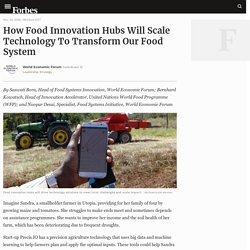
EPRS ATA(2020)656297 EN. Vaccinations obligatoires, le débat confisqué, par Leïla Shahshahani (Le Monde diplomatique, janvier 2018) Les enfants non vaccinés n’auront plus accès aux établissements d’accueil collectifs à compter du 1er juin 2018.
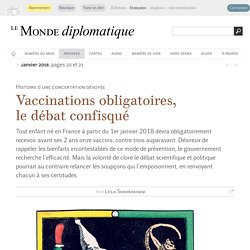
Les sanctions à l’égard des parents réfractaires ne relèveront plus du code de la santé publique spécifique à la vaccination, mais du code pénal relatif à la santé de l’enfant, qui prévoit une peine beaucoup plus lourde (deux ans de prison et 30 000 euros d’amende). La ministre des solidarités et de la santé Agnès Buzyn assume pleinement ce tournant autoritaire avec une expression révélatrice : « La contrainte vise à rendre la confiance (1). » Les onze souches désormais obligatoires (2) correspondent aux « vaccinations jusque-là recommandées sur le calendrier vaccinal (...) dont l’intérêt a été affirmé par le Haut Conseil de la santé publique [HCSP] », explique le professeur Benoît Vallet, chef de la direction générale de la santé (DGS), ajoutant que l’obligation pourra être levée lorsque les couvertures optimales seront atteintes (au moins 95 % de la population).
The Vulnerable Can Wait. Vaccinate the Super-Spreaders First. Au nom de la biosécurité, par Lucile Leclair (Le Monde diplomatique, novembre 2020) Un prétexte sanitaire pour industrialiser davantage l’élevage Comment enrayer les épidémies dans les élevages, d’autant plus inquiétantes que certains virus — impossible de l’ignorer désormais — franchissent la barrière des espèces ?

La réponse sanitaire internationale ressemble à une fuite en avant du modèle industriel. Les mesures prônées menacent la santé et les écosystèmes, tout en condamnant les exploitations à taille humaine. par Lucile Leclair. - PopGen:Live Webinars. The IGF is a global multistakeholder platform that facilitates the discussion of public policy issues pertaining to the Internet. The science behind coronavirus restrictions. More than half a year into the COVID-19 pandemic, scientists across the world are still striving to find out more about the coronavirus.
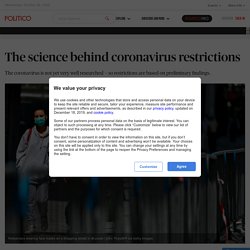
How and where do people get infected — and which measures are effective in containing the spread of the disease? In contrast to the spring, when many countries tried blanket lockdowns, policymakers now have far more research on how the virus is transmitted. Getting back to masks Protective masks are now commonly worn on all public transport in Europe, as well as in stores and in certain places outside, especially in crowded areas. Covid-19: Boosting antiviral research - European Science-Media Hub. Funding research and innovation projects to find a cure for Covid-19 is a vital part of the EU plan to tackle the current coronavirus crisis.

On the 30th January the European commission committed €47.5 million to research projects aimed at understanding the novel coronavirus (SARS-CoV-2) and develop new treatments, diagnostic tests and vaccines. At the time of writing 18 projects involving 136 research teams from across the EU and beyond have been shortlisted for funding. The Commission also called for research proposals by the end of March focusing on developing treatments and diagnostics to tackle the current outbreak and increase preparedness for future, within the framework of the Innovative Medicines Initiative and for a €90 million total investment.
The pandemic has catapulted science to the forefront of policy-making - European Science-Media Hub. Opaque Poll that Negatively Frames AI Will Scare Europeans and Harm Progress. BEUC, the self-proclaimed “consumer voice in Europe,” recently released a report arguing that its survey shows consumers do not trust AI and think it will be used to manipulate them.
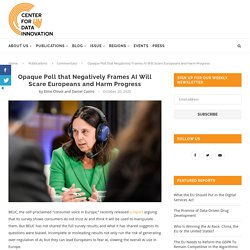
But BEUC has not shared the full survey results, and what it has shared suggests its questions were biased. Incomplete or misleading results not only run the risk of generating over-regulation of AI, but they can lead Europeans to fear AI, slowing the overall AI use in Europe. There are least four problems with BEUC’s survey. First, BEUC’s survey does not provide any meaningful benchmarks for their questions. Trump’s antibody treatment was tested using cells originally derived from an abortion. Last Friday, as Trump developed worrisome symptoms of covid-19, the president received an emergency cocktail of anti-coronavirus antibodies made by Regeneron.
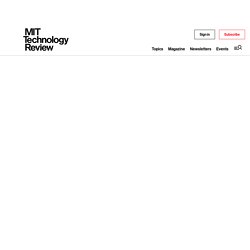
These molecules are manufactured in cells from a hamster’s ovary, so-called “CHO” cells, according to the company—not in human cells. Future Trends in Synthetic Biology—A Report. Introduction Synthetic Biology offers innovative approaches for engineering new biological systems or re-designing existing ones for useful purposes (see Figure 1).
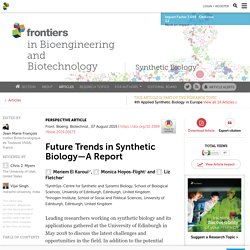
It has been described as a disruptive technology at the heart of the so-called Bioeconomy, capable of delivering new solutions to global healthcare, agriculture, manufacturing, and environmental challenges (Cameron et al., 2014; Bueso and Tangney, 2017; French, 2019). However, despite successes in the production of some high value chemicals and drugs, there is a perception that synthetic biology is still not yet delivering on its promise.
Figure 1. Synthetic biology is developing into a biodesign platform where it will be possible to apply the “design-build-test-iterate (or deploy)” to predictably create cells or organisms able to produce a wide variety of novel molecules, materials or even cells for multiple applications. NIA presents nano in the context of 'Advanced Materials' at OECD online conference. As part of the OECD/German Environment Agency June 16 workshop 'Advanced materials - online conferences.
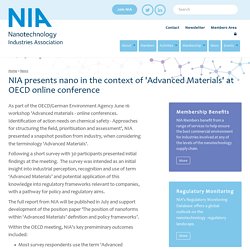
Identification of action needs on chemical safety - Approaches for structuring the field, prioritisation and assessment', NIA presented a snapshot position from industry, when considering the terminology 'Advanced Materials'. Following a short survey with 30 participants presented initial findings at the meeting. The survey was intended as an initial insight into industrial perception, recognition and use of term ‘Advanced Materials’ and potential application of this knowledge into regulatory frameworks relevant to companies, with a pathway for policy and regulatory aims.
The full report from NIA will be published in July and support development of the position paper ‘The position of nanoforms within ‘Advanced Materials’ definition and policy frameworks’. Making Personalized Cancer Vaccines Takes an Army—of Robots. Soya protein can help make lab-grown beef with the texture of meat. Human-like cyborg eye could power itself using sunlight. By Donna Lu Yaying Xu / oFantastic ColorAnimation Technology Co., Ltd A human-like artificial eye capable of being powered by sunlight could eventually be used as a visual aid for people who cannot see.
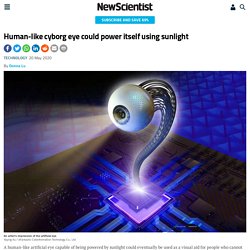
Zhiyong Fan at the Hong Kong University of Science and Technology and his colleagues have developed a spherical visual sensor that mimics the structure of the human eye. Apple’s new watch has a blood oxygen monitor – what is it good for? Wound Healing Biotech Reapplix Raises €20M to Accelerate US Rollout. Biosensors: Monitoring Our Health Anywhere, Anytime. Biosensors are rapidly becoming part of our everyday life. As technology advances, we may soon be able to monitor many aspects of our health at home, in real time, and without needles. Traditionally used in medical practice to monitor patient status, biosensors have recently started to be broadly marketed for wellness and fitness applications. These devices are able to detect a specific molecule that is linked to a health condition, offering an actionable insight into what’s happening in our bodies.
The market for biosensors is growing rapidly. Artificial Proteins Give Living Cells a Computational Upgrade. World’s first living organism with fully redesigned DNA created. What if Covid-19 isn't our biggest threat? With Designer Bacteria, Crops Could One Day Fertilize Themselves. How Synthetic Biology Will Help Me Live Forever. A New Lab Is Brewing Microbes to Create Makeup and Medicines. Scientists Can Finally Build Feedback Circuits in Cells. Synthetic Biology Could Bring a Pox on Us All. Applications and ethics of computer-designed organisms. The Surgisphere Scandal: What Went Wrong?
The EU not ready for the release of Gene drive organisms into the environment. Within the last decades, new genetic engineering tools for manipulating genetic material in plants, animals and microorganisms are getting large attention from the international community, bringing new challenges and possibilities. Programmed bacteria have something extra. Engineering speciation events in insects may be used to control harmful pests. Personalized medicine software vulnerability uncovered: Discovery led researchers to software fix. A weakness in one common open source software for genomic analysis left DNA-based medical diagnostics vulnerable to cyberattacks.
Researchers at Sandia National Laboratories identified the weakness and notified the software developers, who issued a patch to fix the problem. AI and single-cell genomics: New software predicts cell fate. Artificial intelligence applied to the genome identifies an unknown human ancestor. Deep learning takes on synthetic biology: Computational algorithms enable identification and optimization of RNA-based tools for myriad applications.
Nanotechnologies, Advanced Materials, Advanced Manufacturing and Processing, and Biotechnology. The Leadership in Enabling and Industrial Technologies (LEIT) part of Horizon 2020 will support the development of technologies underpinning innovation across a range of sectors. Food Security, Sustainable Agriculture and Forestry, Marine, Maritime and Inland Water Research and the Bioeconomy. Biotechnology. Building antibiotics block by block. Nanomaterials arising amid antibiotic resistance. Second-quarter biotech job picture. Antibacterials get $1 billion injection. The making of the Biohub. Whither COVID-19 vaccines? What is CRISPR and why is it controversial? CRISPR, the revolutionary genetic ‘scissors,’ honored by Chemistry Nobel. Scientists win historic Nobel chemistry prize for 'genetic scissors'
Scientific topic: Biological hazards. This Company Wants to Rewrite the Future of Genetic Disease—Without Crispr Gene Editing. World's first cultivated bacon and pork belly. Can supercomputers help find a COVID-19 treatment?